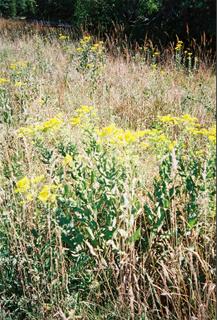

On a "
Wildflower Walk" at the open-air museum in Waukesha County called Old World Wisconsin, a naturalist took us through the prairie fields that are being tended there. The objective is to bring back as many of the native species as possible. However, as any gardener knows, invaders are always present and so we discussed those as well. The naturalist also said that while southeastern Wisconsin had open oak prairies, the eastern counties upstate were usually heavily wooded.
As we walked, I took note of the unfamiliar plants which the 19th century immigrant might have found. And perhaps the alien species traveled as treasured seeds and a reminder of the homeland. The books, WILDFLOWERS OF WISCONSIN by Stan Tekiela and ROADSIDE PLANTS AND FLOWERS by Marian S. Edsall, helped me fill in the holes in my notes for some of the species that we saw.
*
The Black-eyed Susan, a native wildflower of the Wisconsin prairies, needs disturbed earth to reseed. Because the American Indians burned off old, dry vegetation in spring, this wildflower flourished.
*
Compass Plant takes its name from leaves that focus themselves north or south, depending on the time of day.
*
Spiderwort, with its exotic purple-blue flowers that open in the morning and often wilt by noon, was sometimes called "Widow's Tears" because the wilted flower gave off a wet residue. Native plant.
*
New Jersey Tea, a bushy plant with small white flowers, got its name because an ersatz tea could be made from the leaves. This plant's deep roots, which gave off a red juice, could stop a horse-drawn plow. Native plant.
*
Wild Bergamot, often called Bee Balm, Oswego tea or Monarda, is a member of the mint family, and familiar in most Wisconsin gardens today. It was often used as a tea that to treat respiratory and digestive ailments. Native plant.
*
Yarrow comes in many varieties, some native and some Eurasian. It grows in open fields and along roads. The leaves were sometimes chewed as a remedy for toothache.
*
The Prairie Rose is a climbing, single pink rose; the rose hips were used for tea. Native plant.
*
Black Medick is a legume type of plant from the clover family. Its blossoms form into small yellow balls. It increases the fertility of the soil with nitrogen, as do alfalfa and other clover-family plants.
*
White Campion has a daisy-like petal and each petal is notched. There is a small bladder below each flower, distinguishing it from other members of the daisy family. There are both native and alien varieties.
*
Plantain is a low growing plant that has big leaves with ridges that stand out. There is a legend that the plantain was once a woman who stood waiting for a lover who never came. Hence it is thought to heal sore feet. The young leaves can be used for tea.
*
Soapwort, sometimes also called "Bouncing Bet" is a plant with pink or white flowers and indented petals. Its leaves give off a soapy substance and could be used to wash dishes
*
Woodbine, sometimes called Virginia Creeper, looks very much like poison ivy. It is a member of the grape family and will climb trees and fences. It produces a blue-black berry.
*
Fleabane has fringe-like tiny white or yellow daisies. Its crushed leaves were thought to help keep away fleas and insects.
*
Butterfly Milkweed has narrow leaves and deep taproots that help it survive dry weather and mowing. The taproots were once boiled as a treatment for pleurisy. Monarch butterflies are fond of it but unlike the common mildewed, its juice is watery, not milky. Native plant.
*
Wild Indigo, a relative of the clover family, produces a type of blue dye. Its green leaves turn black when dried. It is about the only clover that is a native plant.
*
Common Mullein, sometimes called flannel leaf, is a member of the snapdragon family. Its flower is a club-like spike covered with tiny yellow flowers. It is a European import. It is said that in ancient times the flower heads would be combined, coated with tallow, and lighted to serve as a weapon somewhat similar to the modern flame-thrower. The upper leaves were an old remedy for respiratory problems.
*
Ox-Eye Daisy, with a large flower head, can easily grow wild. The naturalist guide called it a native plant; my flower books say it is a European garden import. It flowers spring and summer. Each petal is actually a composite of several flowers and the center is made up of tiny yellow flower disks.
*
Ragweed, the hay-fever sufferer's nightmare, is a native plant that thrives on disturbed soil. Its green flower heads release the yellow pollen that are the cause of the allergic reaction. It has bitter leaves and will make the milk of any cow desperate enough to eat it too bitter to drink.


